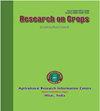评估适合俄罗斯伏尔加河下游地区的冬季粮食作物品种
Q3 Agricultural and Biological Sciences
引用次数: 0
摘要
为了在干旱气候下有效地生产粮食,生产者需要选择冬季作物品种。为此目的,在俄罗斯伏尔加河下游地区典型气候条件的试验田进行了冬小麦和冬大麦品种的生态试验。试验作物小区面积为10 m2,采用3次重复连续重复的方法进行定位。通过生态试验,按前身——黑色休耕,播种各种起源的冬季作物品种,种子田间发芽率为90-95%,出苗率为350万粒。哈,深5-6厘米。试验共有16个冬小麦品种,以唐93为标准品种。对5个冬大麦品种进行了试验,标准品种为沃尔日斯基1号。对所得的产量结果进行方差分析,评价其产量。在冬粮生产工艺过程中,品种价值显著,占72.4%,剩余生产要素占27.5%。冬小麦产量最高的是Tarasovskaya品种(8.5吨/公顷)。试验中产量最低的品种为顿河总督5.7吨/公顷。地方选育品种卡米山卡3号冬小麦高产8.1 t/公顷。冬大麦品种“Buran”的生物产量最高,为6.4 t/ha,主要是由于生产芽数较多(440 pcs/m2),单穗粒重最大(1.46 g),品种“Voskhod”为4.9 t/ha。本文章由计算机程序翻译,如有差异,请以英文原文为准。
Evaluating winter grain crops varieties suitable for the Lower Volga region of Russia
For efficient grain production in arid climate, producers need a choice of winter crop varieties. For this purpose, an ecological test of varieties of winter wheat and winter barley was carried out on experimental fields typical for the climatic conditions of the Lower Volga region of Russia. Plots with experimental crops, with an area of 10 m2, were located by the method of successive repetitions in 3-fold repetition. By the ecological test, varieties of winter crops of various originators were sown, according to the predecessor - black fallow, with seeds with a field germination rate of 90-95%, with a seeding rate of 3.5 million pcs. ha, to a depth of 5-6 cm. There were 16 varieties of winter wheat in the test, Don 93 served as the standard variety. Five varieties of winter barley were tested, the standard variety was Volzhsky 1. The obtained results of the yield of varieties were processed by analysis of variance to assess their yield. It has been established that in the technological process of production of grain of winter crops, the value of the variety is significant and has a share of 72.4%, the remaining factors of production account for 27.5%. The leader in terms of winter wheat yield (8.5 t/ha) was the Tarasovskaya variety. The lowest yield in the test was in the Governor of the Don variety 5.7 t/ha. High yield of winter wheat in the variety of local selection Kamyshanka 3 was 8.1 t/ha. The maximum biological yield of 6.4 t/ha was obtained for the winter barley variety Buran, mainly due to the larger number of productive shoots 440 pcs/m2 and the largest grain mass per spike 1.46 g variety Voskhod 4.9 t/ha.
求助全文
通过发布文献求助,成功后即可免费获取论文全文。
去求助
来源期刊

Research on Crops
Agricultural and Biological Sciences-Soil Science
CiteScore
1.50
自引率
0.00%
发文量
93
审稿时长
1 months
期刊介绍:
The Research on Crops is a peer-reviewed journal publishing original research papers, review articles and short communications in English on all basic and applied aspects of crop sciences, agricultural water management, agro-climatology, agroforestry, agronomy, crop production, crop protection, cropping systems, food science & technology, genetics & plant breeding, horticulture, plant & soil science, plant biotechnology, plant nutrition, post-harvest management of crops, seed science, soil management & tillage, vegetables, weed science, agricultural engineering, agri-business, agricultural economics and extension, etc. The aim of the journal is to provide a forum for the scientific community to publish their latest research findings.
The manuscripts submitted for publication should not contain data older than 4 years on the date of submission.
The articles submitted for publication in this journal should not be submitted elsewhere simultaneously for publication in another journal. These should not carry any copyright material without prior permission of copyright holder.
The articles should present a complete picture of the investigation made and should not be split into parts.
There is no prescribed limit regarding the number of pages in case of full-length articles. However, the authors are advised to keep the length of their articles from 4 to 10 full printed pages of the journal.
The articles should be divided into the sub-sections: ABSTRACT, INTRODUCTION, MATERIALS AND METHODS, RESULTS AND DISCUSSION, CONCLUSIONS, and REFERENCES. Tables and figures should be appended separately at the end.
 求助内容:
求助内容: 应助结果提醒方式:
应助结果提醒方式:


